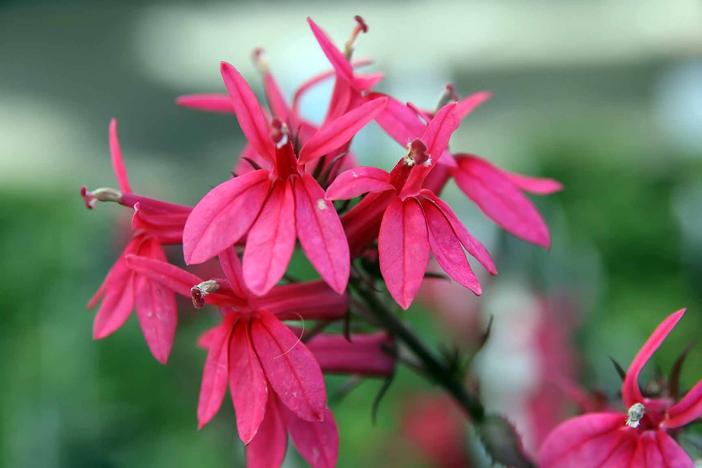Hybrid Cardinal Flower
(Lobelia speciosa)
Hybrid Cardinal Flower (Lobelia speciosa)
/
/

David J. Stang
CC BY-SA 4.0
Image By:
David J. Stang
Recorded By:
Copyright:
CC BY-SA 4.0
Copyright Notice:
Photo by: David J. Stang | License Type: CC BY-SA 4.0 | License URL: https://creativecommons.org/licenses/by-sa/4.0 | Uploader: David Stang | Publisher: Wikipedia Commons














Estimated Native Range
Summary
Lobelia speciosa, commonly known as Hybrid Cardinal Flower, is a deciduous perennial herb that is an artificial hybrid created from crosses between Lobelia cardinalis, Lobelia siphilitica and Lobelia fulgens. Although the parentage species have overlapping native ranges spanning wetlands and streambanks in eastern and southeastern United States, the species is not generally considered naturally occuring. It typically grows to a height of 2-4 feet (0.6-1.2 meters) and a width of 1-2 feet (0.3-0.6 meters). The plant has an upright form with lance-shaped leaves and produces spikes of vibrant red flowers that are highly attractive to hummingbirds and butterflies during its blooming season in late summer and fall.
The Hybrid Cardinal Flower is valued for its showy flowers and ability to attract wildlife. It is often used in rain gardens, borders, and as a naturalizing plant in moist areas of the landscape. It thrives in full sun to part shade and requires consistently moist to wet soils with good organic content for optimal growth. While it is generally easy to maintain, it can be susceptible to root rot if drainage is poor. This plant is not known for aggressive roots or significant disease problems, but slugs and snails can sometimes be pests. It is not typically invasive when grown outside its native range, but care should be taken to prevent it from escaping into natural wetlands where it could potentially outcompete native species.CC BY-SA 4.0
The Hybrid Cardinal Flower is valued for its showy flowers and ability to attract wildlife. It is often used in rain gardens, borders, and as a naturalizing plant in moist areas of the landscape. It thrives in full sun to part shade and requires consistently moist to wet soils with good organic content for optimal growth. While it is generally easy to maintain, it can be susceptible to root rot if drainage is poor. This plant is not known for aggressive roots or significant disease problems, but slugs and snails can sometimes be pests. It is not typically invasive when grown outside its native range, but care should be taken to prevent it from escaping into natural wetlands where it could potentially outcompete native species.CC BY-SA 4.0
Plant Description
- Plant Type: Herb
- Height: 2-4 feet
- Width: 1-2 feet
- Growth Rate: Moderate
- Flower Color: Pink, Red, Purple
- Flowering Season: Summer, Fall
- Leaf Retention: Deciduous
Growth Requirements
- Sun: Full Sun, Part Shade
- Water: High
- Drainage: Slow
Common Uses
Bee Garden, Bird Garden, Border Plant, Butterfly Garden, Deer Resistant, Hummingbird Garden, Low Maintenance, Rock Garden, Salt Tolerant, Showy Flowers, Water Garden
Natural Habitat
Wetlands and streambanks in eastern and southeastern United States
Other Names
Common Names: Cardinal Flower , Pracht-Lobelie , Lobélie , Rabattlobelia , Lobelia
Scientific Names: Lobelia speciosa , Lobelia gerardii , Lobelia siphilitica var. hybrida , Lobelia speciosa nothovar. schneckii , Lobelia ×speciosa var. speciosa , Lobelia cardinalis f. milleri , Lobelia cardinalis var. milleri , Lobelia gerardii var. lugdunensis , Lobelia makoyi , Lobelia milleri
GBIF Accepted Name: Lobelia speciosa Sweet